634662
Titanium(IV) oxide, mixture of rutile and anatase
nanopowder, <100 nm particle size (BET), 99.5% trace metals basis
Sinônimo(s):
Titanium dioxide
About This Item
Produtos recomendados
Nível de qualidade
Ensaio
99.5% trace metals basis
Formulário
nanopowder
tamanho de partícula
<100 nm (BET)
<50 nm (XRD)
cadeia de caracteres SMILES
O=[Ti]=O
InChI
1S/2O.Ti
chave InChI
GWEVSGVZZGPLCZ-UHFFFAOYSA-N
Procurando produtos similares? Visita Guia de comparação de produtos
Categorias relacionadas
Descrição geral
Aplicação
Código de classe de armazenamento
11 - Combustible Solids
Classe de risco de água (WGK)
nwg
Ponto de fulgor (°F)
Not applicable
Ponto de fulgor (°C)
Not applicable
Equipamento de proteção individual
Eyeshields, Gloves, type N95 (US)
Escolha uma das versões mais recentes:
Já possui este produto?
Encontre a documentação dos produtos que você adquiriu recentemente na biblioteca de documentos.
Os clientes também visualizaram
Artigos
Dye-sensitized solar cells directly convert sunlight to electricity
Over the last decade, dye-sensitized solar cells (DSSCs) have attracted much attention because these unconventional solar cells exhibit high performance and have the potential for low-cost production.
One of the more traditional photovoltaic devices, single crystalline silicon solar cells were invented more than 50 years ago, currently make up 94% of the market. Single crystalline silicon solar cells operate on the principle of p-n junctions formed by joining p-type and n-type semiconductors.
Few Monolayer Atomic Layer Deposition (ALD) on Surfaces and Interfaces for Energy Applications
Global Trade Item Number
| SKU | GTIN |
|---|---|
| 131849-10G | 4061838345790 |
| 46014-100MG | 4061832343761 |
| 46014-1EA | |
| 131849-1G | 4061838728609 |
| 131849-500G | |
| 634662-100G | 4061835563449 |
| 634662-25G | 4061832722146 |
Nossa equipe de cientistas tem experiência em todas as áreas de pesquisa, incluindo Life Sciences, ciência de materiais, síntese química, cromatografia, química analítica e muitas outras.
Entre em contato com a assistência técnica
